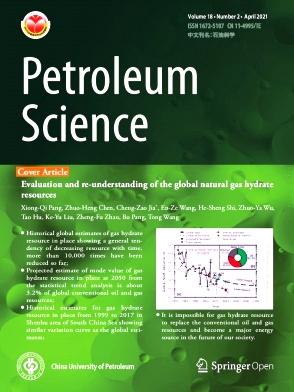Mesoporous SiO2 nanoparticles with low surface energy and multi-level roughness as shale wellbore stabilizers in oil-based drilling fluid
IF 6
1区 工程技术
Q2 ENERGY & FUELS
引用次数: 0
Abstract
Oil-based drilling fluids possess excellent properties such as shale inhibition, cuttings suspension, and superior lubrication, making them essential in the development of unconventional oil and gas reservoirs. However, wellbore instability, caused by the invasion of drilling fluids into shale formations, remains a significant challenge for the safe and efficient extraction of shale oil and gas. This work reports the preparation of mesoporous SiO2 nanoparticles with low surface energy, utilized as multifunctional agents to enhance the performance of oil-based drilling fluids aimed at improving wellbore stability. The results indicate that the coating prepared from these nanoparticles exhibit excellent hydrophobicity and antifouling properties, increasing the water contact angle from 32° to 146° and oil contact angle from 24° to 134.8°. Additionally, these nanoparticles exhibit exceptional chemical stability and thermal resistance. Incorporating these nanoparticles into oil-based drilling fluids reduced the surface energy of the mud cake from 34.99 to 8.17 mJ·m−2 and increased the roughness of shale from 0.26 to 2.39 μm. These modifications rendered the mud cake and shale surfaces amphiphobic, effectively mitigating capillary infiltration and delaying the long-term strength degradation of shale in oil-based drilling fluids. After 28 days of immersion in oil-based drilling fluid, shale cores treated with MF-SiO2 exhibited a 30.5% increase in compressive strength compared to untreated cores. Additionally, these nanoparticles demonstrated the ability to penetrate and seal rock pores, reducing the API filtration volume of the drilling fluid from 11.2 to 7.6 mL. This study introduces a novel approach to enhance the development of shale gas and oil resources, offering a promising strategy for wellbore stabilization in oil-based drilling fluid systems.
求助全文
约1分钟内获得全文
求助全文
来源期刊

Petroleum Science
地学-地球化学与地球物理
CiteScore
7.70
自引率
16.10%
发文量
311
审稿时长
63 days
期刊介绍:
Petroleum Science is the only English journal in China on petroleum science and technology that is intended for professionals engaged in petroleum science research and technical applications all over the world, as well as the managerial personnel of oil companies. It covers petroleum geology, petroleum geophysics, petroleum engineering, petrochemistry & chemical engineering, petroleum mechanics, and economic management. It aims to introduce the latest results in oil industry research in China, promote cooperation in petroleum science research between China and the rest of the world, and build a bridge for scientific communication between China and the world.
 求助内容:
求助内容: 应助结果提醒方式:
应助结果提醒方式:


